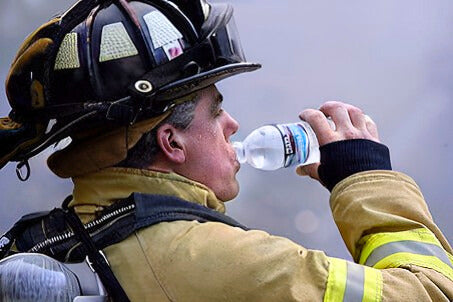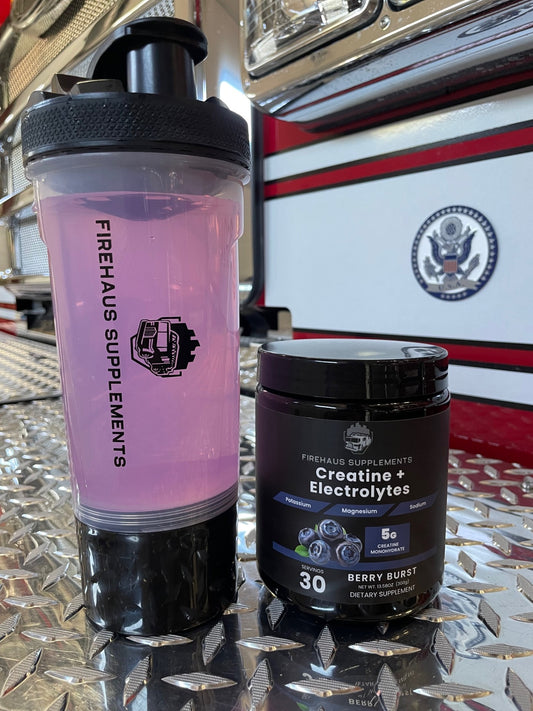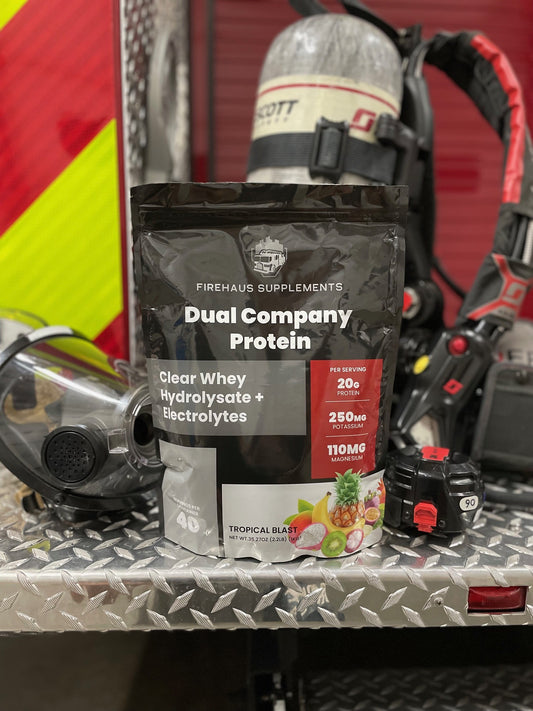
Dehydration in Firefighters: Why It's the Silent Job Hazard and What to Do About It.
Share
Most firefighters are running low — and they're probably not aware
Firefighting is a physical profession that can demand maximum effort. Intense physical work, coupled with high heat and heavy gear is a formula for steady fluid and electrolyte loss. Often times firefighters can literally wring the sweat out of their bunkers after fighting a fire. A growing body of research shows that firefighters commonly arrive at, and leave, incidents in a hypohydrated state. Even mild dehydration (1–2% body mass loss) reduces physical performance and cognitive function like attention, memory, and reaction time. (MDPI)
How common is dehydration in the fire service?
Research shows that most firefighters come off a fire or training already dehydrated. Several studies found that after fireground evolutions firefighters lose enough body weight and show urine changes to clearly indicate dehydration has set in (Horn et al., 2012). In other words — it’s not just in your head when you feel absolutely drained after a fire, your body is most likely entering a dehydrated state. The science confirms it: dehydration is increasingly becoming more common on the fireground.
Field studies and reviews of occupational firefighting tasks repeatedly document measurable fluid losses and indicators of dehydration after structure-fire and training activities. Researchers using body-mass change, urine indices, and other field measures have reported consistent signs of hypohydration in firefighters following suppression tasks and prolonged training. In short: it’s not rare — it’s almost expected unless you deliberately manage fluids. (Taylor & Francis Online)
Why firefighters are especially prone to dehydration
A few job-related factors make firefighters much more likely to lose fluid and electrolytes than the general population:
- Heavy, impermeable personal protective equipment (PPE). Turnout gear traps heat and reduces evaporative cooling, so core temperature and sweating rise faster during work. That increases fluid loss even when work intensity is moderate. (MDPI)
- High ambient heat and radiant exposure. Structure fires expose crews to extreme thermal loads; firefighting in that environment accelerates sweat losses and cardiovascular strain. (CDC)
- Intermittent, high-intensity bursts. Fireground tasks (hose work, forcible entry, dragging victims) are short, maximal efforts repeated over a short period of time — a setting that promotes rapid fluid loss plus delayed thirst signals. (MDPI)
- Limited drinking opportunities. During an incident or while in full gear, practical access to fluids is often restricted — at most incidents firefighters will only have the ability to hydrate when rotated out of a work assignment and sent to rehab/recycle. Depending on available personnel and the size of the incident, these quick breaks can be few and far between. (PMC)
Together these factors mean many firefighters end shifts with measurable dehydration unless pre-, during-, and post-shift hydration is actively managed.
What dehydration does to job performance (and safety)
Even relatively small losses of body water have outsized effects:
- Cognitive decline. A pooled analysis of studies found that dehydration impairs attention, executive function, working memory, and reaction time. These are all abilities firefighters rely on when decisions must be fast and precise. Even ~1–2% body-mass loss is enough to degrade performance on complex tasks. (PubMed)
- Reduced physical work capacity. Dehydration lowers endurance, increases perceived exertion, and reduces strength/power in some settings — meaning hose advances, victim drags, and repeated climbs become harder and slower. (ScienceDirect)
- Greater heat and cardiovascular strain. With lower plasma volume, the heart works harder to maintain flow and cooling. That raises risk for heat illness and cardiovascular events during hot work. NIOSH/occupational evaluations have documented excessive heat strain in live-fire training and operational settings. (CDC)
- Cramping and slower recovery. Electrolyte losses (sodium, potassium, magnesium) that accompany sweat can contribute to muscle cramps and slower post-shift recovery if not addressed. (PMC)
Put bluntly: dehydration makes you slower, less sharp, more fatigued, and more at risk — not a position any crew can afford in an emergency.
Practical, field-tested hydration strategies for firefighters
You can’t eliminate heat or heavy gear, but you can manage hydration proactively. Evidence-based, practical steps:
- Pre-hydrate before shift or training. Start well-hydrated — easy checks like body mass tracking or aiming for pale-yellow urine help. Pre-loading with an appropriately salted fluid (not just water) can be useful before predictable heavy work. (PMC)
- Schedule drinking, not just “drink when thirsty.” During long incidents or training, set short windows for sipping (e.g., every 15–30 minutes when feasible). Ad-lib drinking often underestimates real needs in hot, stressful work. (PMC)
- Use electrolyte-containing fluids for heavy sweating. Sweat contains sodium and other ions; replacing with water and electrolytes can improve fluid retention and avoid diluting blood sodium (which in extreme cases causes hyponatremia). (ScienceDirect)
- Monitor by simple field measures. Track body mass pre/post shift (weigh-in and weigh-out) and urine color. A quick ≥1% body-mass loss is a cue to increase fluid/electrolyte intake; ≥2% is evidence of meaningful dehydration. (PMC)
- Cool-down and recovery fluids. After a job or in between assignments on scene- remove gear ASAP, cool the body, and consume a beverage containing electrolytes and some carbohydrates to speed rehydration and glycogen replenishment. (ScienceDirect)
Why electrolytes matter (short version)
Electrolytes (sodium, potassium, magnesium, etc.) control fluid balance, nerve signaling, and muscle contraction. Heavy sweating removes not just water but salt and minerals; replacing only water can leave you “water-logged” but salt-poor, which impairs muscle and nerve function and can slow fluid absorption. For high-sweat, heat-exposed work like ours, a rehydration approach that includes electrolytes is recommended. (NCBI)
How FireHaus Supplements can help on and off duty
We formulated our frontline supplements with real firefighting needs in mind. Both our Dual Company Protein and Creatine+Electrolytes include added essential electrolytes to help replace what you lose in heavy sweat and to support faster recovery between calls and shifts.
- Creatine+Electrolytes: provides the performance benefits of creatine monohydrate (5 g per serving) plus a tailored electrolyte blend and natural co-ingredients like coconut-water powder. — This supplement is designed to support short bursts of high-intensity work and recovery after calls. Flavored with blueberry powder and containing zero sugar, Creatine+ Electrolytes not only tastes great, but is suitable for low carb diets and lifestyles.
- Dual Company Protein: combines hydrolyzed whey protein and collagen proteins to support muscle repair and recovery. We also added essential electrolytes to help maintain fluid balance after tough shifts. And because it’s a clear protein, it mixes light and refreshing — more like juice than a heavy shake — making it easy to get down during long rotations or after a hot call when you don’t want something thick.
Using targeted supplements — not as a replacement for drinking water, but as part of a hydration and recovery plan — can make the difference between being merely “able to work” and being fully ready, mentally and physically, for the next call.
Bottom line
Dehydration among firefighters is a documented, preventable risk. Even mild fluid losses blunt cognitive sharpness and physical work capacity — two things you can’t afford to lose on the fireground. Use practical strategies (pre-hydration, scheduled sipping, electrolyte replacement, cool down, and simple monitoring) and consider adding electrolyte-containing recovery products to your toolkit. FireHaus Supplements builds those needs into our products because a hydrated, recovered crew is a safer, stronger crew.
Sources & further reading
- Walker, A. et al., The impact of fire suppression tasks on firefighter hydration. (critical review). (PMC)
- Horn, G.P. et al., Quantifying Dehydration in the Fire Service Using Field Methods. (2012). (Taylor & Francis Online)
- Wittbrodt, M.T., Millard-Stafford, M., Dehydration Impairs Cognitive Performance: A Meta-analysis. Med Sci Sports Exerc. 2018. (PubMed)
- Sawka, M.N., et al., Fluid and electrolyte supplementation for exercise heat stress (review). (ScienceDirect)
- Holland-Winkler, A.M., Hydration Considerations to Improve the Physical... (2024). (PMC)






